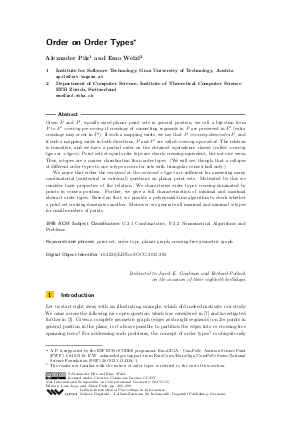Order on Order Types
Authors Alexander Pilz, Emo Welzl
-
Part of:
Volume:
31st International Symposium on Computational Geometry (SoCG 2015)
Part of: Series: Leibniz International Proceedings in Informatics (LIPIcs)
Part of: Conference: Symposium on Computational Geometry (SoCG) - License:
 Creative Commons Attribution 3.0 Unported license
Creative Commons Attribution 3.0 Unported license
- Publication Date: 2015-06-12
File

PDF
LIPIcs.SOCG.2015.285.pdf
- Filesize: 0.52 MB
- 15 pages
Document Identifiers
Subject Classification
Keywords
- point set
- order type
- planar graph
- crossing-free geometric graph
Metrics
- Access Statistics
-
Total Accesses (updated on a weekly basis)
0Document
0Metadata
Abstract
Given P and P', equally sized planar point sets in general position, we call a bijection from P to P' crossing-preserving if crossings of connecting segments in P are preserved in P' (extra crossings may occur in P'). If such a mapping exists, we say that P' crossing-dominates P, and if such a mapping exists in both directions, P and P' are called crossing-equivalent. The relation is transitive, and we have a partial order on the obtained equivalence classes (called crossing types or x-types). Point sets of equal order type are clearly crossing-equivalent, but not vice versa. Thus, x-types are a coarser classification than order types. (We will see, though, that a collapse of different order types to one x-type occurs for sets with triangular convex hull only.) We argue that either the maximal or the minimal x-types are sufficient for answering many combinatorial (existential or extremal) questions on planar point sets. Motivated by this we consider basic properties of the relation. We characterize order types crossing-dominated by points in convex position. Further, we give a full characterization of minimal and maximal abstract order types. Based on that, we provide a polynomial-time algorithm to check whether a point set crossing-dominates another. Moreover, we generate all maximal and minimal x-types for small numbers of points.
Cite As Get BibTex
Alexander Pilz and Emo Welzl. Order on Order Types. In 31st International Symposium on Computational Geometry (SoCG 2015). Leibniz International Proceedings in Informatics (LIPIcs), Volume 34, pp. 285-299, Schloss Dagstuhl – Leibniz-Zentrum für Informatik (2015)
https://doi.org/10.4230/LIPIcs.SOCG.2015.285
BibTex
@InProceedings{pilz_et_al:LIPIcs.SOCG.2015.285,
author = {Pilz, Alexander and Welzl, Emo},
title = {{Order on Order Types}},
booktitle = {31st International Symposium on Computational Geometry (SoCG 2015)},
pages = {285--299},
series = {Leibniz International Proceedings in Informatics (LIPIcs)},
ISBN = {978-3-939897-83-5},
ISSN = {1868-8969},
year = {2015},
volume = {34},
editor = {Arge, Lars and Pach, J\'{a}nos},
publisher = {Schloss Dagstuhl -- Leibniz-Zentrum f{\"u}r Informatik},
address = {Dagstuhl, Germany},
URL = {https://drops.dagstuhl.de/entities/document/10.4230/LIPIcs.SOCG.2015.285},
URN = {urn:nbn:de:0030-drops-51194},
doi = {10.4230/LIPIcs.SOCG.2015.285},
annote = {Keywords: point set, order type, planar graph, crossing-free geometric graph}
}
Author Details
References
-
Oswin Aichholzer, Franz Aurenhammer, and Hannes Krasser. Enumerating order types for small point sets with applications. Order, 19(3):265-281, 2002.

-
Oswin Aichholzer, Jean Cardinal, Vincent Kusters, Stefan Langerman, and Pavel Valtr. Reconstructing point set order types from radial orderings. In ISAAC 2014, volume 8889 of LNCS, pages 15-26. Springer, 2014.

-
Oswin Aichholzer, Thomas Hackl, Matias Korman, Marc van Kreveld, Maarten Löffler, Alexander Pilz, Bettina Speckmann, and Emo Welzl. Packing plane spanning trees and paths in complete geometric graphs. In Proc. 26th Canadian Conference on Computational Geometry (CCCG 2014), 2014.

-
Oswin Aichholzer, Thomas Hackl, Birgit Vogtenhuber, Clemens Huemer, Ferran Hurtado, and Hannes Krasser. On the number of plane graphs. In Proc. 17th Annual ACM-SIAM Symposium on Discrete Algorithms (SODA 2006), pages 504-513. ACM Press, 2006.

-
Oswin Aichholzer and Hannes Krasser. Abstract order type extension and new results on the rectilinear crossing number. Comput. Geom., 36(1):2-15, 2007.

-
Boris Aronov, Paul Erdős, Wayne Goddard, Daniel J. Kleitman, Michael Klugerman, János Pach, and Leonard J. Schulman. Crossing families. Combinatorica, 14(2):127-134, 1994.

-
Prosenjit Bose, Ferran Hurtado, Eduardo Rivera-Campo, and David R. Wood. Partitions of complete geometric graphs into plane trees. Comput. Geom., 34(2):116-125, 2006.

-
Jean Cardinal, Michael Hoffmann, and Vincent Kusters. On universal point sets for planar graphs. In Computational Geometry and Graphs - Thailand-Japan Joint Conference (TJJCCGG 2012), volume 8296 of LNCS, pages 30-41. Springer, 2012.

-
Jacob E. Goodman and Richard Pollack. Multidimensional sorting. SIAM J. Comput., 12(3):484-507, 1983.

-
Jacob E. Goodman and Richard Pollack. Semispaces of configurations, cell complexes of arrangements. J. Combin. Theory Ser. A, 37(3):257-293, 1984.

-
Jan Kynčl. Enumeration of simple complete topological graphs. Eur. J. Comb., 30(7):1676-1685, 2009.

-
Nicolai E. Mnëv. The universality theorems on the classification problem of configuration varieties and convex polytope varieties. In Topology and Geometry - Rohlin Seminar, volume 1346 of Lecture Notes in Math., pages 527-544. Springer, 1988.

-
Michael J. Pelsmajer, Marcus Schaefer, and Daniel Štefankovič. Crossing numbers of graphs with rotation systems. Algorithmica, 60(3):679-702, 2011.

-
Gerhard Ringel. Extremal problems in the theory of graphs. In Theory of Graphs and its Applications (Smolenice, 1963), pages 85-90. Publ. House Czechoslovak Acad. Sci., Prague, 1964.

-
Marcus Schaefer. Complexity of some geometric and topological problems. In Graph Drawing, volume 5849 of LNCS, pages 334-344. Springer, 2009.

-
Géza Tóth and Pavel Valtr. Geometric graphs with few disjoint edges. In Symposium on Computational Geometry, pages 184-191, 1998.

-
Benjamín Tovar, Luigi Freda, and Steven M. LaValle. Learning combinatorial map information from permutations of landmarks. I. J. Robotic Res., 30(9):1143-1156, 2011.

-
Stephen K. Wismath. Point and line segment reconstruction from visibility information. Int. J. Comput. Geometry Appl., 10(2):189-200, 2000.

